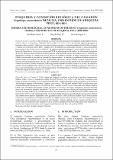Por favor, use este identificador para citar o enlazar este ítem:
https://hdl.handle.net/20.500.12958/3456Registro completo de metadatos
| Campo DC | Valor | Lengua/Idioma |
|---|---|---|
| dc.contributor.author | Pinazo B., Kristhian | - |
| dc.contributor.author | Incio Pérez, Angela | - |
| dc.contributor.author | Campos León, Sarita | - |
| dc.contributor.editor | Instituto del Mar del Perú | - |
| dc.date.accessioned | 2020-09-04T00:33:51Z | - |
| dc.date.available | 2020-09-04T00:33:51Z | - |
| dc.date.issued | 2020 | - |
| dc.identifier.citation | Bol Inst Mar Perú. 35(1) 2020, p. 37-48 | es_ES |
| dc.identifier.isbn | 04587766 | - |
| dc.identifier.uri | https://hdl.handle.net/20.500.12958/3456 | - |
| dc.description.abstract | Se reportan aspectos pesqueros y biológicos del camarón Cryphiops caementarius con base en prospecciones efectuadas en los ríos Majes-Camaná y Ocoña, en el periodo enero 2016 - octubre 2018. El método más empleado durante la época disponible para la pesca fue “buceo con luz artificial”. El esfuerzo pesquero presentó valores estables entre 1,7 y 2,5 horas de faena diaria; los mayores valores de CPUE se registraron en diciembre. Se observaron ejemplares de mayor talla que fueron machos, disminución de talla promedio anual para ambos sexos y aumento de ejemplares juveniles. La proporción sexual estuvo en equilibrio durante la época reproductiva (estación cálida), favoreciendo a los machos durante los demás meses. La madurez gonadal en hembras mostró un patrón similar para ambos ríos con dos periodos bien definidos, uno de octubre a marzo, registrando una elevada actividad reproductiva y otro de abril a setiembre, con inactividad gonadal. El IGS presentó mayores valores de octubre a enero; la frecuencia de ovígeras fue superior de enero a marzo. A su vez, se analizó la relación lineal múltiple de los valores promedio mensuales de las variables biológico-pesqueras del recurso y físicas del medio hídrico, con una correlación positiva entre temperatura y frecuencia de hembras y ovígeras, y relación negativa entre el caudal y la CPUE. | es_ES |
| dc.description.abstract | ABSTRACT: Surveys conducted in the Majes – Camaná and Ocoña rivers, between January 2016 – October 2018, provided information on the fishery and biological aspects of the shrimp Cryphiops caementarius. “Diving with artificial light” was the most used method during the fishing season. The fishing effort varied between 1.7 and 2.5 hours of daily fishing; highest CPUE were recorded in December. Larger specimens were males, the mean annual size decrease for both sexes and increases in juvenile specimens. The sex ratio was in balance during the breeding season (warm season), favoring males in the remaining months. Gonadal maturity in females showed a similar pattern for both rivers with two well defined periods, one from October to March, recording high reproductive activity and another from April to September, with gonadal inactivity. The GSI showed higher values from October to January; the frequency of ovigerous females was higher from January to March. Also, the multiple linear relationship of the monthly mean values of the biological - fishery variables of the resource and the physics of the water environment were analyzed, with a positive correlation between temperature and frequency of females and ovigerous females, and a negative ratio between the flow rate and the CPUE. | - |
| dc.language.iso | spa | es_ES |
| dc.publisher | Instituto del Mar del Perú | es_ES |
| dc.relation.ispartofseries | Boletín IMARPE 35(1), 2020; | - |
| dc.rights | info:eu-repo/semantics/openAccess | es_ES |
| dc.rights.uri | https://creativecommons.org/licenses/by/4.0/ | es_ES |
| dc.source | Instituto del Mar del Perú - IMARPE | es_ES |
| dc.source.uri | Repositorio Digital IMARPE | es_ES |
| dc.subject | Camarón | es_ES |
| dc.subject | Biología | es_ES |
| dc.subject | Cryphiops caementarius | es_ES |
| dc.subject | Perú - Arequipa | es_ES |
| dc.title | Pesquería y condición biológica del camarón Cryphiops caementarius (Molina, 1782) en ríos de Arequipa-Perú, 2016-2018 | es_ES |
| dc.title.alternative | Fishery and biological conditions of the shrimp Cryphiops caementarius (Molina, 1782) in rivers of Arequipa, Peru (2016-2018) | es_ES |
| dc.type | info:eu-repo/semantics/article | es_ES |
| Aparece en las colecciones: | Boletín 35(1), 2020 | |
Ficheros en este ítem:
| Fichero | Descripción | Tamaño | Formato | |
|---|---|---|---|---|
| Boletin 35-1 articulo4.pdf | 2,62 MB | Adobe PDF |  Visualizar/Abrir |
Este ítem está sujeto a una licencia Creative Commons Licencia Creative Commons

